Working long shifts in a healthcare environment often means spending hours on your feet. For nurses and other healthcare professionals, this constant standing, walking, and moving can lead to foot pain. How to prevent foot pain during long shifts isn’t just a comfort issue; it’s a vital part of maintaining your well-being and career longevity.
Ignoring persistent foot pain can have serious consequences. Without proper support and consistent care, the strain on your feet, ankles, knees, hips, and even your back can accumulate, leading to chronic discomfort, injuries, and a significant impact on your quality of life both inside and outside of work.
This comprehensive guide will provide practical, actionable tips about how to reduce and prevent foot pain for long shifts.
Why Nurses Experience Foot Pain During Long Shifts
Understanding the root causes of foot pain is the first step toward preventing it. The unique demands of a nursing role create a perfect storm for discomfort:
- Standing/Walking on Hard Floors:
Most hospital and clinic floors are made of hard materials like concrete or tile. These surfaces offer very little shock absorption, meaning every step and every minute spent standing sends impact forces directly up through your feet and legs.
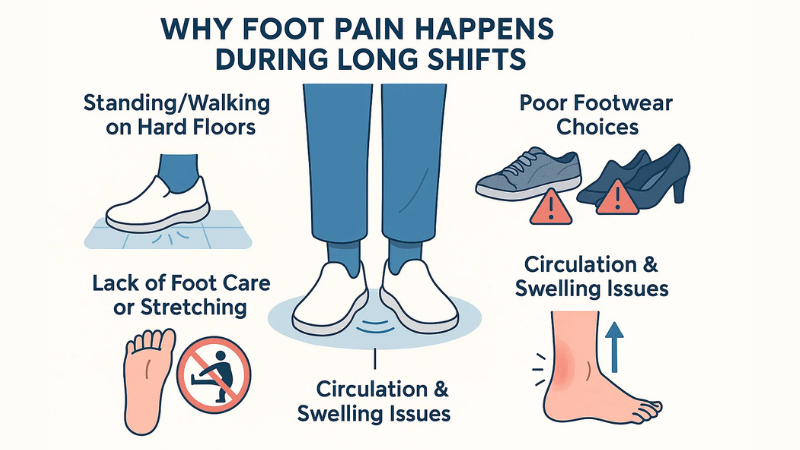
- Poor Footwear Choices:
This is arguably one of the biggest culprits. Shoes that lack proper arch support, cushioning, or are ill-fitting can exacerbate the impact of hard floors. High heels, worn-out sneakers, or shoes that are too tight or too loose all contribute to poor biomechanics and increased strain.
- Lack of Foot Care or Stretching:
Many nurses focus on patient care and neglect their own. Skipping basic foot care routines or not incorporating simple stretches can lead to muscle tightness, reduced flexibility, and increased susceptibility to pain and injury. Feet, like any other part of the body, need regular attention.
- Circulation and Swelling Issues:
Prolonged standing can make it harder for blood to flow back up from your legs to your heart. Gravity causes fluid to pool in your feet and ankles. Poor circulation also hinders the delivery of essential nutrients and oxygen to tired muscles.
Expert Tips to Prevent Foot Pain During Long Shifts
1. Follow Essential Foot Care Tips to Prevent Foot Pain During Long Shifts
Proactive nurse foot care tips are non-negotiable for anyone spending long hours on their feet. Integrating these simple habits into your daily routine can make a significant difference:
Keep Feet Clean and Moisturized:
- Wash your feet daily with mild soap and lukewarm water, paying special attention to the areas between your toes.
- Dry your feet thoroughly to prevent fungal infections, which can compromise skin integrity.
- Apply a good quality, non-greasy moisturizer to your entire foot (but avoid between the toes to prevent moisture buildup). This keeps skin supple and prevents cracks that can lead to soreness or infection.
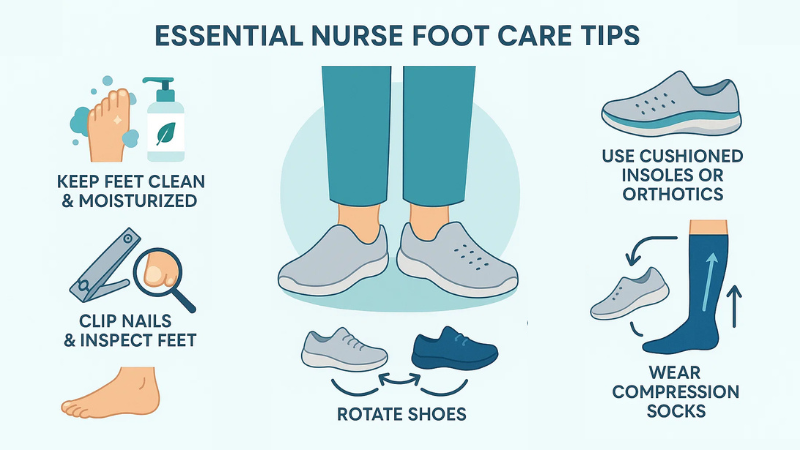
Clip Nails Properly and Inspect Feet Regularly:
- Trim your toenails straight across, avoiding cutting them too short or rounding the corners, which can lead to painful ingrown nails.
- Make a habit of inspecting your feet daily for any cuts, blisters, redness, swelling, or changes in skin color. Early detection of problems is key, especially if you have reduced sensation in your feet.
Use Cushioned Insoles or Orthotic Inserts:
- Even the best nursing shoes can benefit from added support and cushioning. Cushioned insoles provide an extra layer of shock absorption.
- Orthotic inserts offer more targeted support for specific arch types (flat feet, high arches) and can help correct biomechanical issues that contribute to pain.
Rotate Between Two Good Pairs of Shoes:
- Wearing the same pair of shoes every day doesn’t allow the cushioning to fully decompress.
- Rotating between two (or even three) pairs of quality nursing shoes allows each pair to dry out completely and regain its shock-absorbing properties.
Mention Compression Socks:
- These specialized socks apply gentle pressure to your legs, helping to improve blood circulation and prevent fluid from pooling in your feet and ankles. They are incredibly effective at reducing swelling and alleviating tired, achy legs.
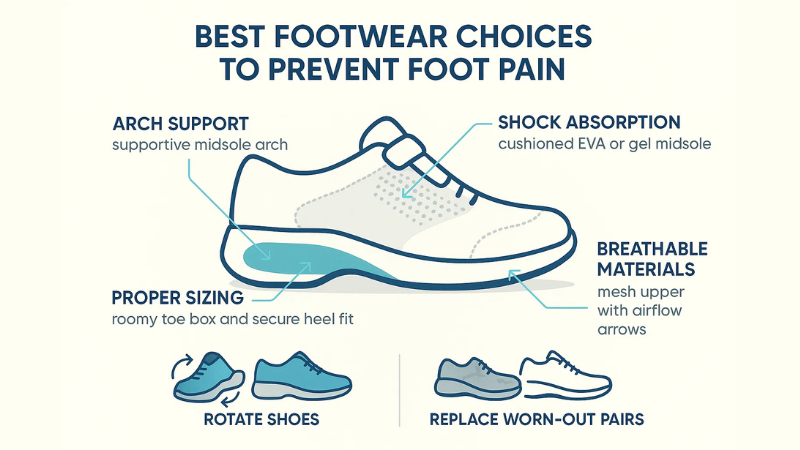
2. Invest in Best Footwear to Prevent Foot Pain During Long Shifts
Your shoes are your first line of defense against foot pain. Investing in the right footwear is not a luxury; it’s a necessity for nurses.
Importance of Arch Support and Shock Absorption:
- Arch Support: Your arch is crucial for distributing weight and absorbing shock. Shoes with good arch support help maintain the natural alignment of your foot.
- Shock Absorption: The midsole of the shoe is responsible for absorbing impact. Look for materials like EVA foam, polyurethane, or gel cushioning that provide excellent shock absorption.
Proper Sizing and Breathable Materials:
- Sizing: Always get your feet measured, especially if it’s been a while. Your foot size can change over time. Ensure there’s enough room in the toe box for your toes to wiggle freely, but that your heel doesn’t slip. Try shoes on at the end of a long day when your feet are slightly swollen.
- Breathable Materials: Materials like mesh, leather, or synthetic blends that allow air circulation help keep your feet cool and dry, preventing blisters and fungal infections. Look for easy-to-clean surfaces as well, given the clinical environment.
Rotate Shoes and Replace Worn-Out Pairs:
- As mentioned under foot care tips, rotating shoes helps them recover.
- Pay attention to the wear patterns on your shoes. If the treads are worn smooth or the cushioning feels flat, it’s time for a new pair. Typically, nursing shoes should be replaced every 6-12 months, depending on wear and tear.
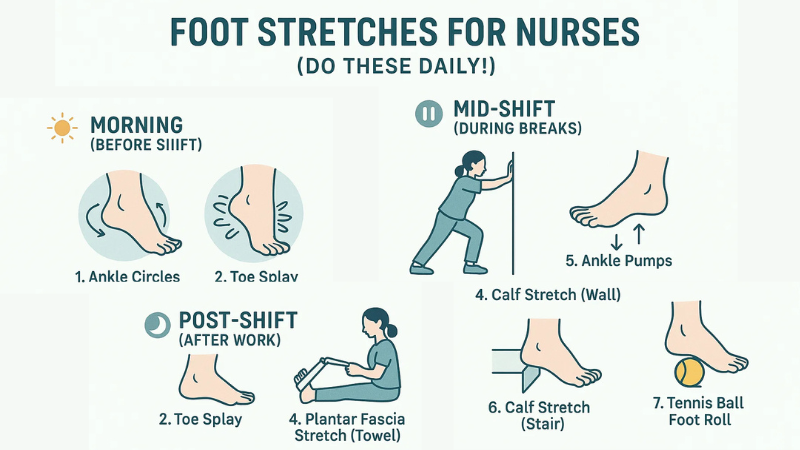
3. Do Daily Stretches That Prevent Foot Pain During Long Shifts
Incorporating foot stretches for nurses into your daily routine can significantly alleviate pain and improve flexibility. These simple exercises can be done at various points throughout your day.
Morning Stretches (Before Your Shift):
- Ankle Circles: Sit in a chair or lie on your back. Lift one foot off the ground and slowly rotate your ankle in circles, clockwise and then counter-clockwise. Repeat 10-15 times per foot. This warms up the ankle joints.
- Toe Splay: While sitting, try to spread your toes as wide as possible and hold for 5 seconds. Relax, then repeat 10 times per foot. This strengthens intrinsic foot muscles.
Mid-Shift Stretches (During Breaks):
- Calf Stretches (Standing): Stand about an arm’s length from a wall. Place your hands on the wall. Step one foot back, keeping your heel on the ground and your leg straight. Lean forward until you feel a stretch in your calf. Hold for 20-30 seconds. Repeat 2-3 times per leg.
- Plantar Fascia Stretch (Seated with Towel): Sit on a chair. Place a towel around the ball of one foot. Keeping your leg straight, gently pull the towel towards you, flexing your foot. You should feel a stretch along the bottom of your foot. Hold for 20-30 seconds. Repeat 2-3 times per foot.
- Ankle Pumps: While sitting, pump your ankles up and down, pointing your toes towards your shin and then away from you. Do this for 30 seconds. This helps with circulation.
Post-Shift Stretches (After Work):
- Calf Stretches (Stair Stretch): Stand on a stair with your heels hanging off the edge. Slowly lower your heels, feeling the stretch in your calves. Hold for 20-30 seconds. Repeat 2-3 times.
- Tennis Ball Foot Roll: Place a tennis ball (or similar firm ball) under your foot. Roll it slowly from your heel to your toes, applying gentle pressure. This massages the arch and can relieve tension in the plantar fascia. Do this for 2-3 minutes per foot.
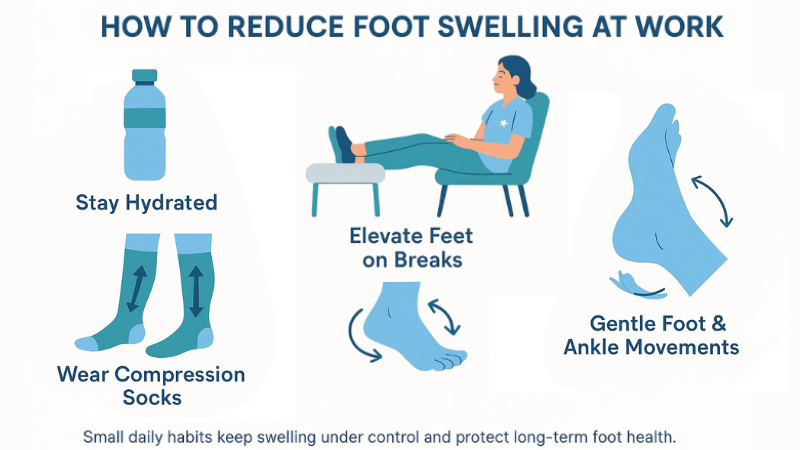
4. Steps to Follow That Reduce Foot Swelling at Work
Swelling is a common complaint, but there are effective ways to reduce foot swelling at work even during long shifts.
- Stay Hydrated:
This might seem counterintuitive, but drinking plenty of water helps your body regulate fluid balance. Dehydration can sometimes cause your body to hold onto water, contributing to swelling. Aim for consistent water intake throughout your shift.
- Elevate Feet During Breaks If Possible:
Even a short period of elevation can make a difference. If you have a break room with a couch or chair, try to prop your feet up above heart level for 10-15 minutes. This helps gravity assist blood flow back to your heart.
- Wear Compression Socks:
As mentioned earlier, compression socks are incredibly effective. They provide graduated pressure, which means the tightest part is at the ankle and gradually loosens towards the knee. This pushes fluid upwards, preventing pooling and reducing swelling.
- Gentle Foot Pumps and Ankle Movements Throughout the Shift:
- While standing or sitting, periodically flex your ankles up and down, and rotate them in circles.
- Do “toe wiggles” by curling and straightening your toes.
- These small movements activate your calf muscles, which act as a pump to push blood and fluid upwards, counteracting gravity’s effects.
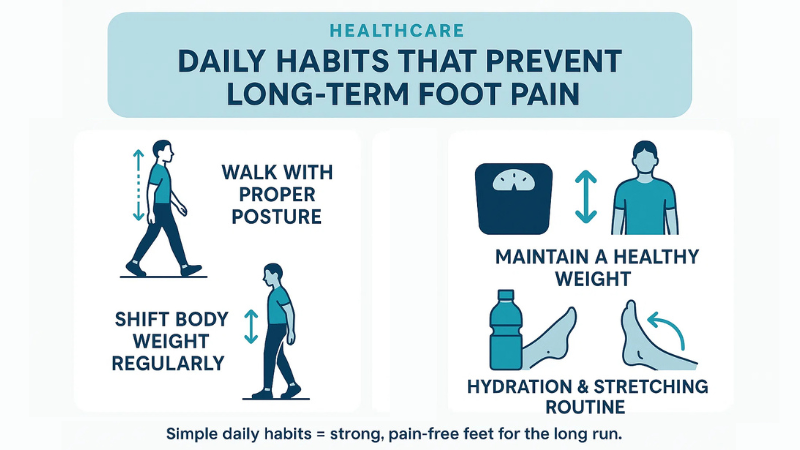
5. Follow Healthy Habits That Prevent Foot Pain During Long Shifts
Beyond immediate relief, establishing daily habits is key to preventing long-term foot pain and maintaining overall foot health.
Walk with Proper Posture:
- Good posture starts from the ground up. Ensure your shoulders are back and down, core engaged, and head aligned over your spine.
- Avoid slouching or shuffling your feet. Proper posture distributes your weight more evenly.
Shift Body Weight Regularly:
- When standing for extended periods, avoid locking your knees.
- Periodically shift your weight from one foot to the other, or from your heels to your toes. This small movement helps to activate muscles and prevent pressure points from building up.
Maintain a Healthy Weight:
- Excess body weight places additional strain on your feet, ankles, and knees.
- Even a modest weight reduction can significantly alleviate pressure on your lower extremities.
Don’t Skip Hydration or Stretching Routines:
- Consistency is key. Make hydration and stretching non-negotiable parts of your daily routine, just like brushing your teeth.
- Set reminders on your phone if needed. Your body will thank you for it in the long run.
Recommended Affiliate Products
Products | |
Compression Socks | |
Gel Shoe Inserts | |
EVA Foam Insole For Wide Feet | |
Orthotic Arch Support Insole |
Conclusion
Foot pain doesn’t have to be an inevitable part of a nurse’s life. By adopting a proactive and comprehensive approach to how to prevent foot pain during long shifts, you can significantly enhance your comfort, reduce the risk of long-term issues, and maintain your overall well-being.
Remember, your feet are your foundation. Investing in proper footwear, integrating daily stretches, practicing consistent foot care, and utilizing recovery techniques are not just good habits – they are essential strategies for a sustainable and comfortable career. Build a daily routine that prioritizes your foot health, and you’ll find yourself stepping through your shifts with greater ease and less discomfort.
FAQs: Preventing Foot Pain During Long Shifts
Here are answers to some common questions about preventing foot pain during long shifts:
What are the best ways to prevent foot pain for nurses on long shifts?
The best ways include wearing supportive, well-fitting shoes with good arch support, using cushioned insoles, performing regular foot stretches, wearing compression socks, and elevating your feet during breaks.
Do foot stretches actually help nurses reduce pain?
Yes, absolutely! Regular foot and calf stretches help to improve flexibility, reduce muscle tension, and increase circulation, all of which contribute significantly to pain reduction and prevention.
How can I reduce swelling in my feet during work hours?
To reduce swelling, stay well-hydrated, wear compression socks, elevate your feet during breaks, and perform gentle foot and ankle movements periodically throughout your shift.
What are the best products to relieve tired legs after work?
Effective products include Epsom salts for foot soaks, foam rollers or massage tools, and cool compresses or alternating hot/cold baths.
Are compression socks effective for standing all day?
Yes, compression socks are highly effective for individuals who stand all day. They apply graduated pressure to the legs, which helps to improve blood circulation.

Leave a Reply